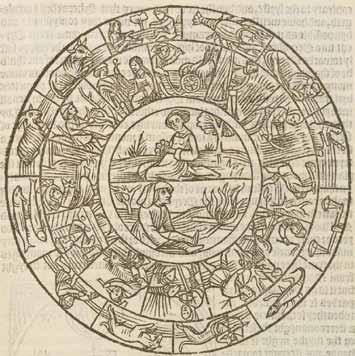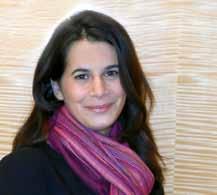
6 minute read
Seasons in the Middle Ages
By Dr Carl Watkins (1998)
It is something of a cliché that we, thanks to the insulating effects of technology, have ceased to live lives ordered by the seasons and that this detachment from nature’s rhythms is something that separates us sharply from the experience of our forefathers. But how, exactly, did the seasons structure the lives and thoughts of our ancestors and how did they make sense of them?
Advertisement
In a project begun during a year of research leave, I am beginning to probe literature and art, chronicles and sermons, scientific writings, estate management treatises and much more to try to get a grip on how men and women in the Middle Ages thought about the seasons and how their lives were structured by them.

The topic is thorny because material for it is scattered in so many different places and in so many different kinds of texts and other media, but it is also tricky because some of our basic assumptions need to be unpicked at the outset. For example, a year comprising four seasons is not a given. It had to be invented – or, perhaps more accurately, imported. Old English literature – which is notably preoccupied with winter’s oppressive grip and the comparative feebleness of summer warmth suggests a year that was divided into two rather than four, split between winter and summer. The four-season year had Latin and continental origins, but it became a powerful framework for understanding time during the Middle Ages. In this tradition, the seasons were nestled in a bigger cosmology in which four was a potent number. There were, for example, four elements (earth, air, fire and water), four bodily ‘humours’, four principal winds, signs of the zodiac divided into four ‘triplicities’ (each tied to one of the elements), as well as the months divided among the four seasons. Neat arithmetic of this kind revealed something of the divine intelligence that had fashioned creation, and that intelligence – and divine solicitude for humankind – was palpable in the way the year turned too, passing through winter, spring, summer and autumn.
A commonplace piece of medieval art that captured the rhythm, and in so doing also celebrated the sacredness of time, was the ‘Labours of the Months’. These images pictured each month with a characteristic activity – maybe parishioners beating the bounds in April, or the threshing of corn in September, pig-sticking in November or feasting by a blazing fire in December. The Labours were painted on church walls, carved on choir stalls, cut into fonts, illuminated in the pages of prayer books and remembered in poetry. One Magdalene manuscript calendar, in the Pepys Library, even has on the reverse of the calendar-page a series of drawings of the Labours that someone has added freehand, matched to the months. So the Labours, and their message about the cycles of time and rhythms of life were ubiquitous.
It might also be tempting to take these little works of art as evidence for life. But this might be a mistake. They are not depictions of reality. Some cycles do not even match the kinds of agricultural tasks undertaken in the places where they appear. They also do not do justice to the variability of experience in a northwestern maritime zone. For if the way that we think about – and interact – with the seasons has changed beyond all measure since the Middle Ages, the reality that the seasons in the British Isles vary a good deal from one year to the next is a historical constant. And beyond that elementary pattern of unpredictability, medieval climate change was as much of a reality as its modern counterpart, though it was a work of nature rather than man.
The twelfth and thirteenth centuries were warm enough for grapes to flourish in many parts of England, and the line of arable cultivation crept upwards too during this period – facilitated by a beneficent climate and propelled by a growing population – until land above 300 metres was being worked on Dartmoor and in the Pennines and Lammermuir Hills. But then in the early fourteenth century there was a rude shock. In 1309 the Thames froze solid. People danced and even lit fires on the ice. It was a taste of things to come, the first stirrings of cooling that would eventuate in the ‘Little Ice Age’ and prefiguration of the famous Frost Fairs held on the Thames in the seventeenth century. But in the mid 1310s it was less cold winters than unseasonably wet summers that caused the trouble, bringing famine to western Europe as rains washed out the corn crops. The calamity was subsequently buried by the even bigger one of the Black Death that struck mid-century, but the crisis of the early fourteenth century saw perhaps a tenth of England’s population perish from starvation.
Historians have studied the economy and demography of these years, but have been less interested in the cultural consequences. How were the unseasonal seasons interpreted? Were they tribulations visited on sinners? Did they get tangled up in apocalyptic thought, construed as signs of the end of the world? Or were they – as some began to argue – natural phenomena that arose from a malign conjunction of planets. Chroniclers and sermon writers reveal the contours of some explanations, but early ‘weather forecasters’ – scholar-churchmen who thought they could detect in the motions of the heavens explanations for inclement conditions – suggest others. All of these ideas were canvassed, and the current project is leading me to examine them.
There are other questions too. Whatever unstable seasons meant to medieval people, they also had to be managed. In the later Middle Ages there was interest in trying to do this. There is evidence, for example, of the use of weather ‘prognostics’ to get a sense of things to come. These worked in varied ways. Some assumed that the elements on each of the twelve days of Christmas would reveal the character of corresponding months, or that the month of the year in which thunder was first heard (a prognostic known as a ‘brontology’) would make it possible to gauge the likely harvest. More sophisticated predictions used astrology to the same effect, giving rise to texts that look a bit like almanacs. So even as the idealised orderliness of the seasons was celebrated, we find evidence of men and women grappling with seasons that (perhaps increasingly) went awry.
So just before we become too wistful about a past in which man lived life in harmony with the seasons, the hard world of the fourteenth century supplies a reality check. For the late medieval record supplies not only bucolic portrayals of labour and leisure, it brings out too the hard realities of lives lived in the grip of a nature that was volatile and often brutal – and the ways in which human beings, as a result, seized on predictive ‘sciences’ that, they hoped, would insulate them from its dangerous vagaries.
Dr Carl Watkins
Dr Carl Watkins is a Magdalene Fellow and Director of Studies in History. He is the University Senior Lecturer in Central Medieval History and was awarded a Pilkington Prize by the University as an acknowledgement of his outstanding contribution to teaching. He carries out research into religious culture in the central and later middle ages and is especially interested in beliefs about, and conceptualisations of the supernatural in this period. His work encompasses the methodological problems of studying medieval religion, ‘high’ theological change and ‘popular’ beliefs about the afterlife, ghosts, angels and demons, miracles and divine signs.
www.magd.cam.ac.uk









